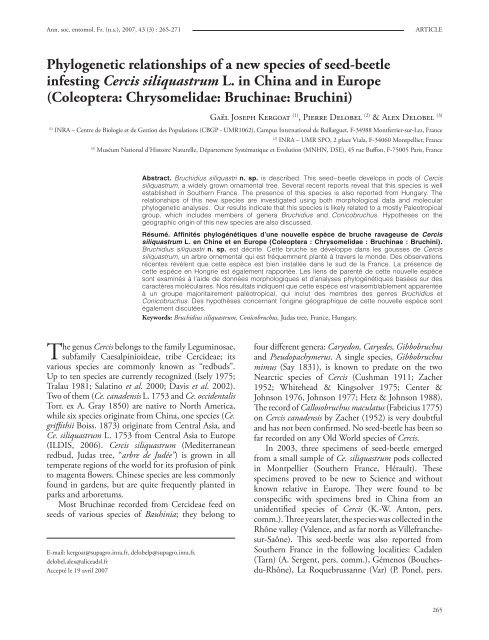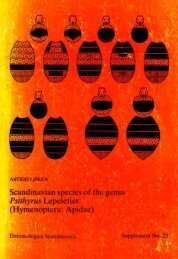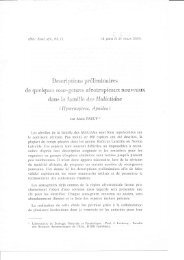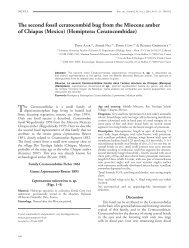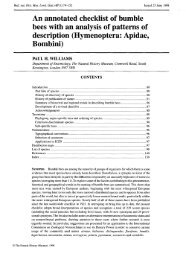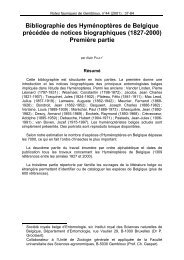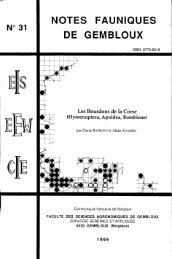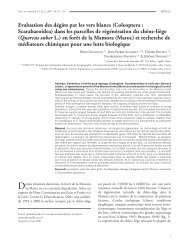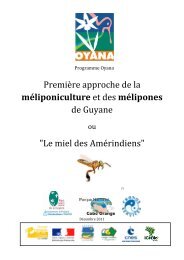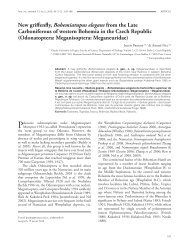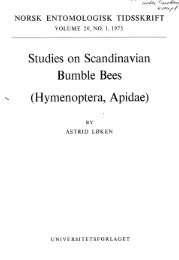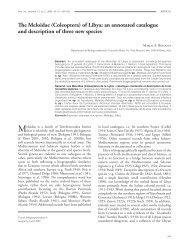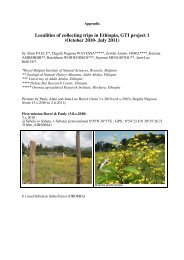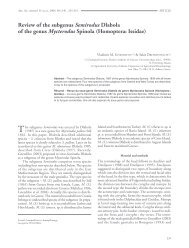Phylogenetic relationships of a new species of seed-beetle infesting ...
Phylogenetic relationships of a new species of seed-beetle infesting ...
Phylogenetic relationships of a new species of seed-beetle infesting ...
Create successful ePaper yourself
Turn your PDF publications into a flip-book with our unique Google optimized e-Paper software.
Ann. soc. entomol. Fr. (n.s.), 2007, 43 (3) : 265-271ARTICLE<strong>Phylogenetic</strong> <strong>relationships</strong> <strong>of</strong> a <strong>new</strong> <strong>species</strong> <strong>of</strong> <strong>seed</strong>-<strong>beetle</strong><strong>infesting</strong> Cercis siliquastrum L. in China and in Europe(Coleoptera: Chrysomelidae: Bruchinae: Bruchini)Gaël Joseph Kergoat (1) , Pierre Delobel (2) & Alex Delobel (3)(1)INRA – Centre de Biologie et de Gestion des Populations (CBGP - UMR1062), Campus International de Baillarguet, F-34988 Montferrier-sur-Lez, France(2)INRA – UMR SPO, 2 place Viala, F-34060 Montpellier, France(3)Muséum National d’Histoire Naturelle, Département Systématique et Evolution (MNHN, DSE), 45 rue Buffon, F-75005 Paris, FranceAbstract. Bruchidius siliquastri n. sp. is described. This <strong>seed</strong>–<strong>beetle</strong> develops in pods <strong>of</strong> Cercissiliquastrum, a widely grown ornamental tree. Several recent reports reveal that this <strong>species</strong> is wellestablished in Southern France. The presence <strong>of</strong> this <strong>species</strong> is also reported from Hungary. The<strong>relationships</strong> <strong>of</strong> this <strong>new</strong> <strong>species</strong> are investigated using both morphological data and molecularphylogenetic analyses. Our results indicate that this <strong>species</strong> is likely related to a mostly Paleotropicalgroup, which includes members <strong>of</strong> genera Bruchidius and Conicobruchus. Hypotheses on thegeographic origin <strong>of</strong> this <strong>new</strong> <strong>species</strong> are also discussed.Résumé. Affinités phylogénétiques d’une nouvelle espèce de bruche ravageuse de Cercissiliquastrum L. en Chine et en Europe (Coleoptera : Chrysomelidae : Bruchinae : Bruchini).Bruchidius siliquastri n. sp. est décrite. Cette bruche se développe dans les gousses de Cercissiliquastrum, un arbre ornemental qui est fréquemment planté à travers le monde. Des observationsrécentes révèlent que cette espèce est bien installée dans le sud de la France. La présence decette espèce en Hongrie est également rapportée. Les liens de parenté de cette nouvelle espècesont examinés à l’aide de données morphologiques et d’analyses phylogénétiques basées sur descaractères moléculaires. Nos résultats indiquent que cette espèce est vraisemblablement apparentéeà un groupe majoritairement paléotropical, qui inclut des membres des genres Bruchidius etConicobruchus. Des hypothèses concernant l’origine géographique de cette nouvelle espèce sontégalement discutées.Keywords: Bruchidius siliquastrum, Conicobruchus, Judas tree, France, Hungary.The genus Cercis belongs to the family Leguminosae,subfamily Caesalpinioideae, tribe Cercideae; itsvarious <strong>species</strong> are commonly known as “redbuds”.Up to ten <strong>species</strong> are currently recognized (Isely 1975;Tralau 1981; Salatino et al. 2000; Davis et al. 2002).Two <strong>of</strong> them (Ce. canadensis L. 1753 and Ce. occidentalisTorr. ex A. Gray 1850) are native to North America,while six <strong>species</strong> originate from China, one <strong>species</strong> (Ce.griffithii Boiss. 1873) originate from Central Asia, andCe. siliquastrum L. 1753 from Central Asia to Europe(ILDIS, 2006). Cercis siliquastrum (Mediterraneanredbud, Judas tree, “arbre de Judée”) is grown in alltemperate regions <strong>of</strong> the world for its pr<strong>of</strong>usion <strong>of</strong> pinkto magenta flowers. Chinese <strong>species</strong> are less commonlyfound in gardens, but are quite frequently planted inparks and arboretums.Most Bruchinae recorded from Cercideae feed on<strong>seed</strong>s <strong>of</strong> various <strong>species</strong> <strong>of</strong> Bauhinia; they belong toE-mail: kergoat@supagro.inra.fr, delobelp@supagro.inra.fr,delobel.alex@aliceadsl.frAccepté le 19 avril 2007four different genera: Caryedon, Caryedes, Gibbobruchusand Pseudopachymerus. A single <strong>species</strong>, Gibbobruchusmimus (Say 1831), is known to predate on the twoNearctic <strong>species</strong> <strong>of</strong> Cercis (Cushman 1911; Zacher1952; Whitehead & Kingsolver 1975; Center &Johnson 1976, Johnson 1977; Hetz & Johnson 1988).The record <strong>of</strong> Callosobruchus maculatus (Fabricius 1775)on Cercis canadensis by Zacher (1952) is very doubtfuland has not been confirmed. No <strong>seed</strong>-<strong>beetle</strong> has been s<strong>of</strong>ar recorded on any Old World <strong>species</strong> <strong>of</strong> Cercis.In 2003, three specimens <strong>of</strong> <strong>seed</strong>-<strong>beetle</strong> emergedfrom a small sample <strong>of</strong> Ce. siliquastrum pods collectedin Montpellier (Southern France, Hérault). Thesespecimens proved to be <strong>new</strong> to Science and withoutknown relative in Europe. They were found to beconspecific with specimens bred in China from anunidentified <strong>species</strong> <strong>of</strong> Cercis (K.-W. Anton, pers.comm.). Three years later, the <strong>species</strong> was collected in theRhône valley (Valence, and as far north as Villefranchesur-Saône).This <strong>seed</strong>-<strong>beetle</strong> was also reported fromSouthern France in the following localities: Cadalen(Tarn) (A. Sergent, pers. comm.), Gémenos (Bouchesdu-Rhône),La Roquebrussanne (Var) (P. Ponel, pers.265
G. J. Kergoat, P. Delobel & A. Delobelcomm.) and Nice (Alpes-Maritimes) (M. Clément, pers.comm.). It was also recently reported from Hungary(O. Merkl, pers. comm.)In this study, the <strong>new</strong> <strong>species</strong> is described and its<strong>relationships</strong> with other bruchines are investigated usingboth morphological data and molecular phylogeneticanalyses.Material and MethodsSamples <strong>of</strong> recently matured pods <strong>of</strong> Cercis siliquastrum werefirst collected in Montpellier in June 2003. Additional materialwas collected from the same location during the summer <strong>of</strong>2004, from Valence (Drôme) in 2005 and from Villefranchesur-Saône(Rhône) in early 2006. Pods were kept in aeratedplastic vials until emergence <strong>of</strong> adults.Morphological analysisMale and female genitalia were mounted on microscope slidesin water-soluble DMHF (dimethyl hydantoin formaldehyde).Figures <strong>of</strong> genitalia were drawn from microphotographs <strong>of</strong> slidepreparations. Male and female habitus were captured usinga Canon EOS 350D digital single lens camera with a MPE65 mm MACRO lens. Body length was measured from apex<strong>of</strong> pronotum to apex <strong>of</strong> elytra. The terminology <strong>of</strong> genital partsfollows Kingsolver (1970).Molecular phylogenetic analysesDNA was extracted from an ethanol preserved specimen usingthe Qiagen DNeasy tissue kit (Qiagen, GmbH, Germany).Partial sequences from three mitochondrial genes (12S rRNA,cytochrome b and cytochrome c oxidase subunit I) wereobtained using standard protocol described elsewhere (Kergoatet al. 2004). In order to minimize the computational time <strong>of</strong>the phylogenetic analyses, a two-steps strategy was followed.First, we have conducted preliminary analyses on a large dataset <strong>of</strong> 152 <strong>species</strong> to identify the closest relatives <strong>of</strong> the <strong>new</strong><strong>species</strong>. Genbank sequences (as well as unpublished datafrom G.J. Kergoat) from four genes (12S rRNA, cytochromeb, cytochrome c oxidase subunit I and 28S-D2 rDNA) wereconcatenated and aligned using ClustalX (Thompson et al.1997) with default settings. MrBayes 3.12 (Huelsenbeck &Ronquist 2001) was used to perform partitioned Bayesiananalyses (one partition per gene; two distinct runs <strong>of</strong> 10million generations; burnin period <strong>of</strong> 100,000 generations).For each gene, the best-fit substitution model was determinedusing Modeltest (Posada & Crandall 1998). In all analyses,Pachymerus cardo (Fahraeus 1839) (Chrysomelidae: Bruchinae:Pachymerini) and Gibbobruchus sp. (Chrysomelidae: Bruchinae:Bruchini) were used as outgroups, following previous studies(e.g. Kergoat et al. 2005).More thorough analyses were subsequently performed onthe data set determined by preliminary analyses, using twoinference methods (Bayesian inference and parsimony).Bayesian inference analyses were carried out with the settingsused beforehand. For parsimony, the program PAUP* 4.0b10(Sw<strong>of</strong>ford 2002) was used to perform unweighted analyseswith the following options: heuristic search with 1,000random-addition replicates; Tree-bisection-reconnection (TBR)algorithm; Maxtrees set to 1,000; Random addition sequences.Since a preliminary incongruence length difference test (ILD;Farris et al. 1994) was not significant, the whole data set wasanalyzed simultaneously. In all parsimony analyses, gaps wereconsidered as a fifth character following Giribet & Wheeler(1999). The robustness <strong>of</strong> trees was assessed by non-parametricbootstrap procedures (1,000 replicates; Felsenstein 1985) forparsimony analyses and by clade posterior probabilities (CPP)for Bayesian inference analyses (Huelsenbeck et al. 2002).ResultsDescription <strong>of</strong> the <strong>new</strong> <strong>species</strong>Bruchidius siliquastri Delobel, n. sp.Figure 1Bruchidius siliquastri n. sp. A, habitus <strong>of</strong> female; B, female pygidium,showing foveae; C, male pygidium.Type material. Holotype. ♂ «France, Hérault, Montpellier,rue Las Cazes [43°37‘03“N 3°51‘01“E], 30.VII.2004 exCe. siliquastrum, C. & P. Delobel coll. CP97 » « Bruchidiussiliquastri n. sp., A. Delobel des. 1997 » « HOLOTYPE » [red].Paratypes: 16 males, 21 females, same data and collectors asholotype; 13 males, 19 females, same data, but 24.VII.2004,ENSA Bat. 28, CP92; 1 male, 2 females, same data, but June2003, P. Delobel coll., Fr 33; all specimens in the collections <strong>of</strong>MNHN. Additional material. 1 male, 1 female, France, Drôme,SEFRA [43°37‘N 3°51‘E], 8.VIII.2005, ex Ce. siliquastrum,P. Delobel coll., CP051558.Description. Length (pronotum-pygidium): 2.8–3.7 mm.Body (fig. 1) short ovate, integument, including legs andantennae, black, abdomen yellowish–red, except ventrite 1partly black basally. Often extreme apex <strong>of</strong> femora and ventral266
A <strong>new</strong> <strong>seed</strong>-<strong>beetle</strong> <strong>species</strong> <strong>infesting</strong> redbudspart <strong>of</strong> hind tarsi very slightly reddish; 4 anterior (specially fore)legs sometimes not black, but rather <strong>of</strong> a dark reddish brown.Vestiture made <strong>of</strong> thin and short setae, rather dense, thoughnot completely covering integument, recumbent, except onbasal part <strong>of</strong> ventrite 1; dorsally composed <strong>of</strong> whitish setae, lessdense on sides and apex <strong>of</strong> elytra, denser on disc and scutellum;on pronotum, setae longer on disc and basal lobe, becomingshorter and less dense on sides; pygidium almost uniformlycovered with short and thin setae; setae moderately long onventral side.Male. Head short; eyes bulging, maximum head width 1.43times width behind eyes; eyes separated by 0.35 times headwidth including eyes; distance between posterior rim <strong>of</strong> eyesand apex <strong>of</strong> clypeus / distance between eyes = 1.76; eye cleftto about half <strong>of</strong> its length, width at bottom <strong>of</strong> sinus composed<strong>of</strong> 7-8 ommatidia; maximum width <strong>of</strong> postocular lobesequal to 1/3”’ eye width at sinus; carina on frons absent, nointerocular tubercule. Antenna <strong>of</strong> moderate length, slightlysurpassing elytral base; antennal segments 2-3 subcylindrical,almost equal in length, segments 5-11 widened at apex, butalways longer than wide, 11 oval (L/W = 2.1). Length <strong>of</strong>antennomeres: 1.4 : 1 : 1.4: IA: 1.5 : 1.6: 1.6 : 1.7: 1.7 : 13: 2.6.Pronotum strongly convex, with greatest width at base(W/L = 1.57),subtrapezoidal, its sides convex at about 2/3 <strong>of</strong> itslength from base; without oblique impression on sides <strong>of</strong> basallobe. Its disc with strong, well separated punctures, becomingstronger and slightly coriaceous laterally; punctuation suddenlyinterrupted on posterior half <strong>of</strong> sides, where integument isalutaceous, with a slight carina-like separation between the twoareas. Elytra short, 1.04 times longer than combined width,their sides strongly convex, maximum width at middle; discflattened; base <strong>of</strong> interstriae 2-4 margined, with a very smalltooth at base <strong>of</strong> stria 3. Striae on disc well defined; interstriaeflat, strongly alutaceous, with irregular lines <strong>of</strong> larger punctures.Hind femora incrassate, at their widest 1.8 times wider thanmid femora; mesoventral margin carinate, with small preapicaldenticle, immediately followed by a much shorter one (visibleonly at higher magnification); hind tibiae widened apically, withdorsomesal and ventral carinae complete and strong, lateral notreaching base; apex <strong>of</strong> tibia with mucro shorter than width<strong>of</strong> tarsomere 1 at base; lateral denticle as long as mucro, anddorsal denticles 1/2 <strong>of</strong> lateral denticle. First tarsomere ventrallywithout apical denticle.Abdomen with ventrite 5 emarginate, medially as longas sternite 4; ventrite 1 basally with a large patch <strong>of</strong> shorterect setae reaching beyond middle <strong>of</strong> ventrite; these setaeslightly scaly, 2–3 times shorter and much denser than thoseon surrounding integument (fig. 2). Pygidium subcircular(W/L = 1.01), with apex turned under (see fig. 1).Genitalia (fig. 3): Median lobe <strong>of</strong> moderate length (maximumwidth excluding basal hood / total length = 0.27); ventralvalve subtriangular, moderately sclerotized, bearing numeroussensillae and on each side a row <strong>of</strong> 10 to 13 short setae; valveflanked by a pair <strong>of</strong> large hinge sclerites; internal sac with twoor three large pointed denticles. Basal strut without keel. Laterallobes cleft to 0.6 their length; apex <strong>of</strong> parameres with numerouslong setae.Female. Similar to male, but last abdomina1 ventrite notemarginate, longer than 4 th ventrite, pygidium slightlynarrower than in male (L/W = 1.05), bearing a pair <strong>of</strong>elongated foveae (see fig. 1); foveae 0.3 to 0.4 mm long, 0.1wide, moderately deep, unmargined, their bottom withoutsetae, slightly alutaceous. Genitalia: spiculum gastrale as infig. 4; spermathecal body narrow and strongly curved, with anelongated apical diverticulum; opening <strong>of</strong> spermathecal glandFigure 2Bruchidius siliquastri n. sp. Detail <strong>of</strong> male ventrite 1, showing the largesetiferous patch.Figure 3Bruchidius siliquastri n. sp. Male genitalia, ventral view. A, median lobe;B, tegmen.267
G. J. Kergoat, P. Delobel & A. Delobelduct basal, contiguous with spermathecal duct opening; vaginawith a large sclerite on dorsal side, a little behind spermathecalduct opening (fig. 4). Bursa copulatrix without spines orneedles.Host plants. All examined material was reared from mature<strong>seed</strong>s <strong>of</strong> Cercis siliquastrum.Etymology. The name refers to the name <strong>of</strong> the host-plant,Cercis siliquastrum.Distribution. China, France and Hungary. Probably present inseveral other European countries.Figure 4Bruchidius siliquastri n. sp. Female genitalia. A, lateral view; B, dorsal view;C, speculum gastrale.Molecular phylogenetic analysesIn all preliminary analyses, B. siliquastri was foundclustered within a clade constituted by <strong>species</strong> belongingto genera Bruchidius Schilsky 1905, ConicobruchusDecelle 1951 and Megabruchidius Borowiec 1984.Based on this result, a subset <strong>of</strong> 21 <strong>species</strong> (includingthe two outgroup <strong>species</strong>) was defined (see tab. 1) andanalyzed following the methods described above.A mean sequence divergence (K2P distance) <strong>of</strong>16.68 ± 0.72% is found between B. siliquastri andthe other 19 ingroup <strong>species</strong> (the closest <strong>species</strong> beingConicobruchus strangulatus (Fahraeus 1839), with15.51% <strong>of</strong> divergence). This value is consistent withthe mean sequence divergence <strong>of</strong> 15.53 ± 3.70% thatwas found when considering the whole subset <strong>of</strong> 21<strong>species</strong>. Bayesian inference and parsimony analysesyield topologies that are quite distinct (fig. 5). UnderTable 1. Taxon sampling.Species Taxonomic group (if any) LocalityBruchidius antennatus (Wollaston 1864) biguttatus Tenerife, Canary IslandsBruchidius biguttatus (Olivier 1795) biguttatus Gard, FranceBruchidius chloroticus (Dalm. 1833)Fatick, SénégalBruchidius cisti (Fabricius 1775) cisti Umbria, ItalyBruchidius holosericeus (Schönherr 1832) holosericeus Kfar Selouane, LebanonBruchidius lichenicola (Wollaston 1854) lichenicola La Palma, Canary IslandsBruchidius lineatopygus (Pic 1924) lineatopygus Louga, SénégalBruchidius lutescens (Blanchard 1844) cisti Fokida, GreeceBruchidius nodieri (Pic 1943)Louga, SénégalBruchidius pauper (Boheman 1829) pauper Haute Corse, FranceBruchidius poupillieri (Allard 1868) cisti Basilicata, ItalyBruchidius siliquastri n. sp.Hérault, FranceBruchidius unicolor (Olivier 1795) cisti Vaucluse, FranceConicobruchus albopubens (Pic 1931)Cabo Verde, SénégalConicobruchus indicus (Pic 1909)IndiaConicobruchus strangulatus (Fahraeus 1839)Cabo Verde, SénégalGibbobruchus sp.Guyane françaiseMegabruchidius dorsalis (Fahraeus 1839)JapanMegabruchidius tonkineus (Pic 1904)Hô Chi Minh-Ville, VietnamMegabruchidius sophorae Tuda & Morimoto 2004Tsukuba, JapanPachymerus cardo (Fahraeus 1839)Guyane française268
A <strong>new</strong> <strong>seed</strong>-<strong>beetle</strong> <strong>species</strong> <strong>infesting</strong> redbudsparsimony, two most-parsimonious trees (3075 steps;CI = 0.459; RI = 0.357) are found, which only differby the position <strong>of</strong> B. lichenicola (Wollaston 1854).The latter <strong>species</strong> is found either as the sister <strong>species</strong><strong>of</strong> Conicobruchus indicus (Pic 1909) or in a morebasal position (see fig. 5). Interestingly, both methodsrecover three clades that are similar in composition(entitled A, B and C; see fig. 5). Clade A groupstogether the three <strong>species</strong> <strong>of</strong> Megabruchidius, with ahigh support (CPP and bootstrap <strong>of</strong> 100%). Clade Bis constituted by African and Asian <strong>species</strong> (with theexception <strong>of</strong> B. lichenicola, which is endemic to theCanary Islands) belonging to the genera Bruchidiusand Conicobruchus. In this clade Bruchidius siliquastriis found either in a basal position, under Bayesianinference (CPP <strong>of</strong> 75%), or clustered with Co.strangulatus, under parsimony (bootstrap <strong>of</strong> 29%).Finally, clade C gathers the European <strong>species</strong> belongingto the Bruchidius biguttatus-cisti-holosericeus-paupergroups (sensu Borowiec 1988).DiscussionFigure 5<strong>Phylogenetic</strong> <strong>relationships</strong> <strong>of</strong> the sampled bruchine <strong>species</strong>. The tree <strong>of</strong> the left corresponds to the result <strong>of</strong> the Bayesian inference analyses with numbers atnodes indicating CPP values (only values >50% are figured). The tree on the right corresponds to one <strong>of</strong> the two most-parsimonious trees from the parsimonyanalysis <strong>of</strong> the combined data set with numbers at nodes indicating bootstrap values (only values >50% are figured). The three clades that are recovered byboth analyses are indicated by capital letters (A, B and C).269
G. J. Kergoat, P. Delobel & A. DelobelMale morphology is characterized by the presence <strong>of</strong>a large setiferous patch on the first ventrite. Abdominalsetiferous areas were described in a number <strong>of</strong> members<strong>of</strong> the subtribe Acanthoscelidina: Acanthoscelideslobatus (Fall 1910) (Johnson 1970), A. quadridentatus(Schaeffer 1907), Bruchidius aurivillii (Blanc 1889),B. uberatus (Fahraeus 1839), Megabruchidius tonkineus(Pic 1904) (Faustini & Halstead 1982), Scutobruchusceratiobruchus (Philippi 1859) (Kingsolver 1968), andis present in a large number <strong>of</strong> tribes, including the basaltribe Pachymerini. The presence <strong>of</strong> large hinge scleritesin the median lobe <strong>of</strong> the <strong>new</strong> <strong>species</strong> is a feature thatis rather common in various African and Asian <strong>species</strong>presently known as Bruchidius or Conicobruchus spp.,particularly in B. bimaculatopygus, B. confusus andB. lineatopygus. The particular conical sclerites <strong>of</strong> theinternal sac are also <strong>of</strong> a rather uncommon type. Similarsclerites are found in Bruchidius danilevskyi Anton1999, B. sapamoroensis Kingsolver 1984, B. savitskyiAnton 1999 and B. tuberculicauda Lukjanovitch &Ter-Minassian 1957. But the latter four <strong>species</strong> share aventral valve that is definitely more pointed than in thepresent <strong>species</strong>. Female morphology is characterized bythe presence <strong>of</strong> a pair <strong>of</strong> longitudinal depressions locatedon the sides <strong>of</strong> the pygidium. Pygidial depressions wereso far known only in the B. centromaculatus group(Faustini & Halstead 1982; Anton & Delobel 2003);foveae in B. siliquastri are however quite distinctivebecause they are not limited by any sort <strong>of</strong> carina.Molecular analyses indicate a close relationshipbetween B. siliquastri and an assemblage <strong>of</strong> <strong>species</strong>belonging to the genera Bruchidius and Conicobruchus(clade B in both trees). This grouping is also suggestedby the fact that a member <strong>of</strong> this group, Co. strangulatus,exhibits the lowest level <strong>of</strong> sequence divergence withB. siliquastri. The level <strong>of</strong> support for the clade B isnot high, as indicated by a moderately high CPP value(75%) and by low bootstrap values (below 50%).Having said that, the results <strong>of</strong> molecular analysesare consistent with the morphological evidence thatbrings together B. siliquastri with the <strong>species</strong> thatpossess similar large hinge sclerites in the medianlobe. Interestingly the latter character is shared by all<strong>species</strong> belonging to clade B, with the exception <strong>of</strong> B.lichenicola.Though our initial sampling <strong>of</strong> 152 <strong>species</strong> wasquite dense (for instance, B. aurivillii and members<strong>of</strong> B. centromaculatus group with pygidial depressionswere included), we only partly manage to get some <strong>of</strong>the key-<strong>species</strong> that possess one <strong>of</strong> the characteristicfeatures <strong>of</strong> B. siliquastri (i.e., particular sclerites <strong>of</strong> theinternal sac, pygidial depressions or setiferous areas).In the absence <strong>of</strong> a denser sampling, the hypothesis<strong>of</strong> a close relationship between B. siliquastri and the<strong>species</strong> related to the other members <strong>of</strong> clade B thusappears as the most likely. In addition, our analysesreveal the paraphyly <strong>of</strong> the genus Conicobruchus, andthe paraphyly <strong>of</strong> the group cisti. These preliminaryresults highlight the need <strong>of</strong> pursuing studies in thetaxonomy and systematics <strong>of</strong> Old-World <strong>seed</strong>-<strong>beetle</strong>sin order to clarify their phylogenetic <strong>relationships</strong>.They justify our present conservative decision not tocreate a <strong>new</strong> genus, and to ascribe the <strong>new</strong> <strong>species</strong> tothe genus Bruchidius.The fact that this <strong>species</strong> was also reported fromunidentified <strong>species</strong> <strong>of</strong> Cercis in China, and itsrelatedness with non-European bruchines allows usto discuss <strong>of</strong> the likely alien status <strong>of</strong> this <strong>species</strong> inEurope. Given the rather conspicuous appearance <strong>of</strong>B. siliquastri (at least for a <strong>seed</strong>-<strong>beetle</strong>) and the widenative area <strong>of</strong> distribution <strong>of</strong> Ce. siliquastrum (fromEurope and Central Asia) it seems difficult to explainwhy this <strong>seed</strong>-<strong>beetle</strong> was not discovered earlier. Arecent shift <strong>of</strong> B. siliquastri from Oriental <strong>species</strong> <strong>of</strong>Cercis toward Ce. siliquastrum thus appears as the mostlikely explanation. We can postulate that this <strong>species</strong>is now present in many other countries (and perhapsin the New World too), due to the popularity <strong>of</strong> theEuropean redbud as an ornamental tree. To conclude,we suggest surveying the possible development <strong>of</strong> this<strong>seed</strong>-<strong>beetle</strong> <strong>species</strong> on other commonly grown Cercis<strong>species</strong>, and especially on the two New World <strong>species</strong>that appear to be closely related with Ce. siliquastrumaccording to recent molecular analyses (Davis et al.2002).Acknowledgements. The authors wish to thank L. Soldati forhis help with the preparation <strong>of</strong> the digitally captured specimens,and M. Clément, J.-P. Hébrard, P. Ponel and A. Sergent for theadditional reports <strong>of</strong> this <strong>new</strong> <strong>species</strong> in France.ReferencesAnton K.-W., Delobel A. 2003. African <strong>species</strong> <strong>of</strong> the Bruchidiuscentromaculatus group with “eyed” female pygidium (Coleoptera:Bruchidae: Bruchinae). Genus 14: 159-190.Borowiec L. 1988. Bruchidae-Strakowce (Insecta: Coleoptera). Fauna Polski,tom 11. PWN, Warszawa.Center T.D., Johnson C.D. 1976. Host plants and parasites <strong>of</strong> someArizona <strong>seed</strong>-feeding insects. Annals <strong>of</strong> the Entomological Society <strong>of</strong>America 69: 195-201.Cushman R.A. 1911. Notes on the host plants and parasites <strong>of</strong> some NorthAmerican Bruchidae. Journal <strong>of</strong> Economic Entomology 4: 489-510.Davis C.C, Fritsch P.W., Li J., Donoghue M.J. 2002. Phylogeny andbiogeography <strong>of</strong> Cercis (Fabaceae): Evidence from nuclear ribosomal ITSand chloroplast ndhF sequence data. Systematic Botany 27: 289-302.Farris J.S., Källersjö M., Kluge A.G., Bult. C. 1994. Testing significance<strong>of</strong> incongruence. Cladistics 10: 315-319.270
A <strong>new</strong> <strong>seed</strong>-<strong>beetle</strong> <strong>species</strong> <strong>infesting</strong> redbudsFaustini D.L., Halstead D.G.H. 1982. Setiferous structures <strong>of</strong> maleColeoptera. Journal <strong>of</strong> Morphology 173: 43-72.Felsenstein J. 1985. Confidence limits on phylogenies: An approach usingthe bootstrap. Evolution 39: 783-791.Giribet G., Wheeler W.C. 1999. On gaps. Molecular <strong>Phylogenetic</strong>s andEvolution 13: 132-143.Hetz M., Johnson C.D. 1988. Hymenopterous parasites <strong>of</strong> some bruchid<strong>beetle</strong>s <strong>of</strong> North and Central America. Journal <strong>of</strong> Stored ProductsResearch 24: 131-143.Huelsenbeck J.P., Miller R.E., Ronquist F. 2002. Potential applicationsand pitfalls <strong>of</strong> Bayesian inference <strong>of</strong> phylogeny. Systematic Biology 51:673-688.Huelsenbeck J.P., Ronquist F. 2001. MrBayes: Bayesian inference <strong>of</strong>phylogeny. Bioinformatics 17: 754-755.ILDIS 2005. International legume database and infornation service. LegumeWeb. http://www.ildis.org. Cited 15 Dec. 2005.Isely D. 1975. Leguminosae <strong>of</strong> the United States: II. SubfamilyCaesalpinioideae. Memoirs <strong>of</strong> the New York Botanical Garden 25: 1-228.Johnson C.D. 1970. Biosystematics <strong>of</strong> the Arizona, California, and Oregon<strong>species</strong> <strong>of</strong> the <strong>seed</strong> <strong>beetle</strong> genus Acanthoscelides Schilsky (Coleoptera:Bruchidae). University <strong>of</strong> California Press, Berkeley, Los Angeles,London, 116 p.Johnson C.D. 1977. Notes on the host plants and distribution <strong>of</strong>Acanthoscelides pauperculus (LeConte) (Coleoptera: Bruchidae).Pan-Pacific Entomologist 53: 303-304.Kergoat G.J., Delobel A., Fédière G., Le Rü B., Silvain J.-F. 2005. Bothhost-plant phylogeny and chemistry have shaped the African <strong>seed</strong><strong>beetle</strong>radiation. Molecular <strong>Phylogenetic</strong>s and Evolution 35: 602-611.Kergoat G.J., Delobel A., Silvain J.-F. 2004. Phylogeny and hostspecificity<strong>of</strong> European <strong>seed</strong> <strong>beetle</strong>s (Coleoptera, Bruchidae), <strong>new</strong>insights from molecular and ecological data. Molecular <strong>Phylogenetic</strong>sand Evolution 32: 855-865.Kingsolver J.M. 1968. A <strong>new</strong> genus <strong>of</strong> Bruchidae from South Americawith the description <strong>of</strong> a <strong>new</strong> <strong>species</strong>. Proceedings <strong>of</strong> the EntomologicalSociety <strong>of</strong> Washington 70: 280-286.Kingsolver J.M. 1970. A study <strong>of</strong> male genitalia in Bruchidae (Coleoptera).Proceedings <strong>of</strong> the Entomological Society <strong>of</strong> Washington 72: 370-386.Posada D., Crandall K.A. 1998. MODELTEST: testing the model <strong>of</strong>DNA substitution. Bioinformatics 14: 817-818.Salatino A., Salatino M.L.F., Giannasi D.E. 2000. Flavonoids and thetaxonomy <strong>of</strong> Cercis. Biochemical Systematics and Ecology 28: 545-550.Sw<strong>of</strong>ford D.L. 2002. PAUP*. <strong>Phylogenetic</strong> Analysis Using Parsimony (*andOther Methods). Version 4.0b10, Sinauer Associates, Sunderland, MA.Thompson J.D., Gibson T.J., Plewniak F., Jeanmougin F., Higgins D.G.1997. The ClustalX windows interface: flexible strategies for multiplesequence alignment aided by quality analysis tools. Nucleic AcidsResearches 24: 4876-4882.Tralau H. 1981. Index Holminiensis. Swedish Natural Science ResearchCouncil, Stockholm.Whitehead D.R., Kingsolver J.M. 1975. Biosystematics <strong>of</strong> the North andCentral American <strong>species</strong> <strong>of</strong> Gibbobruchus (Coleoptera: Bruchidae:Bruchinae). Transactions <strong>of</strong> the American Entomological Society101:167-225.Zacher F. 1952. Die Nährpflanzen der Samenkäfer. Zeitschrift fürangewandte Entomologie 33: 460-480.271


